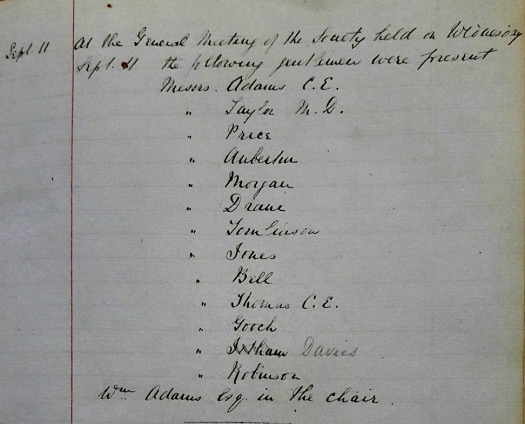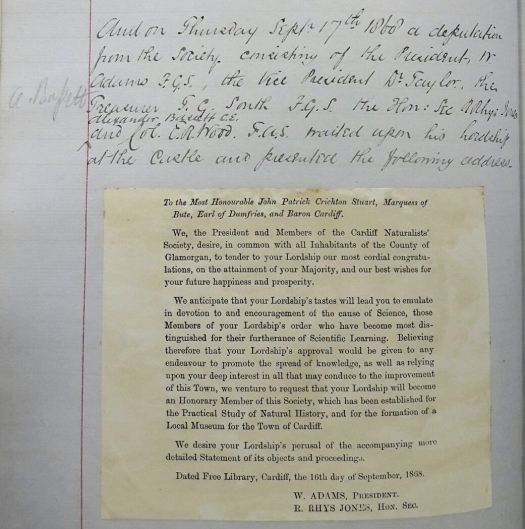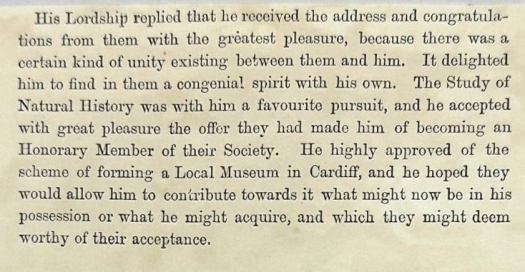On the 11th September 2017 the Cardiff Naturalists’ Society celebrates its 150th anniversary. The society is the longest established wildlife organisation in the area and its anniversary is being marked with an exhibition at The Cardiff Story illustrating the Society’s rich history. The exhibition has a particular focus on the founding of the society, its role in the creation of the National Museum, scientific discoveries and prominent members.
Established, initially, to promote the study of natural history, geology and the physical sciences, the Society’s records, including its minute books, circulars and reports, are held at the Glamorgan Archives. The records provide a detailed account of both the creation of the society and its many and varied activities from 1867 to the present day.
The first reference to a ‘Society’ was in August 1867 with the note of …the preliminary meeting of the members of the projected ‘Naturalists’ Society’ held in the upper room of the Free Library… on 29 August 1867. Chaired by William Taylor, Esq, MD and attended by 11 in total, it was agreed that the Society be called the Cardiff Naturalists’ Society and that …a Committee be formed to prepare rules for the regulation of the Society. Four days later the group met again to agree the rules. Although later amended and extended the original regulations set out in the Minute book, on 2 September 1867, envisaged the object of the Society to be The practical study of Natural History, Geology and Physical Sciences and the formation of a Museum in connection with the Free Library. The planning committee had already advertised in local newspapers for members and made a point of emphasising that …ladies be eligible for membership.

With the agreement of the purpose and regulations the first full meeting was held on 11 September 1867. The meeting was chaired by William Adams, the first President of the Society, who was a civil and mining engineer from Rhymney. The minutes list the 24 members in attendance that day although, despite advertising for members and the commitment to open the doors to women, all were men.

What then of the Fossil ferns and reed … also an antique silver ring and specimen of white rock recorded in the minute book? The Society was established for its members to share and develop their knowledge of all aspects of the natural sciences. To this extent, while the Society had many eminent speakers and organised seminars and field trips, it was expected that members would share their knowledge, research and in some cases private collections. For example, at the first meeting several members brought, for display and examination collections of butterflies and mosses.
There was also a commitment, from the outset, to promote an interest in the natural sciences to the people of the rapidly expanding town of Cardiff. In particular, the Society aimed to develop an extensive and well stocked Museum. The early meetings of the Society used the Museum Room of the Free Library in St Mary Street, provided free of charge on the understanding that the Society would develop and expand the Museum’s collection. The Society addressed this by using its funds to purchase books and exhibits for the Museum, and members were encouraged to add to the collection with exhibits …to be deposited in the Cardiff Museum and become the property of the Corporation of Cardiff.
The minutes for the 11 September meeting state that fossil ferns and reed, an antique silver ring and a specimen of white rock were the very first to objects to be donated to the Society’s collection and, therefore, to the Museum. Significantly they were provided by Robert Drane who, until his death in 1914, was probably the best known and remembered member of the Cardiff Naturalists’ Society in this early period. Drane, who moved to Cardiff in 1855 at the age of 22, is commemorated by a brass plaque at the site of his pharmacy in Queen Street that states:
Here lived Robert Drane FLS naturalist, antiquary and connoisseur. This tablet was erected to his memory by the Cardiff Naturalists’ Society which was founded in these premises in the year 1867.
As the records confirm, Drane was one of the 24 inducted into the Society on 11 September and he was elected at that meeting to the Society’s Committee. In addition, he was the first life member of the Society, being the only one to take up the option, at the first meeting, of purchasing a life membership for the fee of three guineas. It interesting to note that of the 24 present only 15 paid their fees that day and the Society soon introduced further regulations to confirm that All Members whose Subscriptions are one year in arrear shall forfeit their privileges of Membership. Those who are two years in arrear shall have their names erased.
On accepting the Presidency of the Society almost thirty years later, in 1896, Drane remarked:
This Society first opened its eyes in a little room behind a chemist’s shop in 1867 when there were but three persons present – Mr Phil Robinson, Mr R Rhys Jones and myself, and I alone of these am with you now. For these reasons, and because I am the original life member, I may, in some sort, claim to be its founder.
For Drane it was a typically elliptical and rather teasing statement. For whatever reasons, Robert Drane had not been at the planning meetings and was not one of the officers of the Society identified in the notices placed, in August 1867, in the local newspapers. Yet he was clearly identified as a key figure in the Museum Sub-committee of the Free Library established in 1864. In particular, he had taken the lead in improving and extending the range of exhibits held at the Museum. For example, the minutes record that, on 22 March 1864, Mr Drane be authorized to buy British Birds stuffed for the Museum at his direction – not exceeding £5 value.
As a key player in previous attempts to improve the Museum’s collection and, as someone with an active interest in just about all aspects of the natural sciences, Robert Drane would have been well known to those who gathered to set out the Society’s regulations, including Peter Price, a fellow member of the Museum sub-committee, and Philip Robinson of the Free Library. It is very likely, therefore, that plans for the creation of the Society were hatched at a meeting in Drane’s shop as claimed in the Queen Street plaque. There is just one fly in the pharmacist’s ointment; Drane did not move to the Queen Street premises until late in 1867 or more likely 1868. The meeting referred to was, therefore, almost certainly held at his first shop at 11 Bute Street. However, such a minor slip should not be allowed to detract from such a good story.
Within a year, membership of the Society stood at 76. The acceptance, in 1868, by the Marquess of Bute of an Honorary Membership was a particular feather in the Society’s cap and a sign of its growing influence and prestige.


By 1905, when the Society was the driving force behind the recommendation to the Privy Council that the National Museum be located in Cardiff, it was the largest scientific society in Wales.
The Cardiff Naturalists’ Society, therefore, quite rightly, lays claim to having been a key agent in the promotion of the study of the natural sciences. As the Society celebrates its 150th anniversary, it would be interesting to know whether, somewhere within the collections held in Cardiff, there is still a place for the fossils, silver ring and rock donated by Robert Drane in 1867.
The story of the Society can be followed through the records held at Glamorgan Archives of both the Cardiff Naturalists’ Society, 1867-1991 (ref. DCNS) and the papers of Robert Drane (ref. DXIB).
Tony Peters, Glamorgan Archives Volunteer

Many thanks Tony for this fascinating information which certainly adds to the information that we have made available to help celebrate our 150th and you do shed some insight into the standard perceived story of the founding with this additional research
We held our Annual General Meeting last night with a presentation by Mike Dean (Secretary) and myself showing many of the things that we have rediscovered in the Archives which are now being so carefully looked at by the Glamorgan Archives team and we are pleased to see that people such as yourselves are joining in this revival of our history
As part of the Celebrations we currently have an exhibition at the Cardiff Story Museum and we have placed some additional information onto our website at http://cardiffnaturalists.org.uk/htmfiles/150th-00.htm
Also as a matter of interest for you, the logo which we are using for the exhibition was discovered in the Archives, digitized and coloured by Rhian Kendall, Artist, Geologist and CNS member and we have decided that we will return to using this on our Newsletters from now on
We also have a special evening event with Iolo Williams coming up at the National Museum of Wales with information and Tickets available here http://cardiffnaturalists.org.uk/htmfiles/iolo2017
You, your colleagues and your readers would be most welcome to join us at that evening event
Andy Kendall
Former President CNS
Fossil ferns and reed…also an antique silver ring and a specimen of white rock: The Founding of the Cardiff Naturalists’ Society in September 1867. - Glamorgan Archives